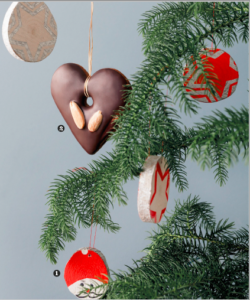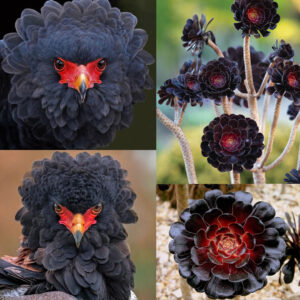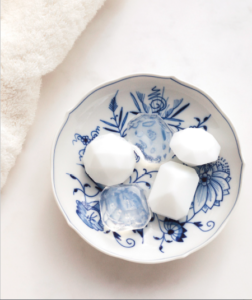Add elegance to your modern home this season with a beautiful gypsophila wreath. The delicate flowers and soft hues offer a simple but stunning reminder to savor winter. Easy to make, this wreath will impress guests and add a touch of sophistication to any decor style. So let your creativity bloom and bring joy to your home this Christmas.
 Pin
Pin Baby’s breath, also known as gypsophila, is the perfect element to add to your wreath for an effortless yet stunning look. Even without additional decorations, it will add a touch of elegance to your design. However, if you are feeling creative, you can always add some baubles or bells to elevate the look further. Don’t be afraid to experiment and make it your own! With baby’s breath, the possibilities are endless. So go ahead, give it a try and watch as your wreath comes to life with its delicate beauty.
 Pin
Pin You will need:
- White metal ring, 20–30cm (8–12in) in diameter
- Gypsophila
- Ribbon, for hanging
- Scissors
- Thin wire
How to make Winter Wreath?
Step 1: Cut little offshoots from the gypsophila, then take 1 or 2 of these together, lay the stems along the metal ring and wrap thin wire around them 3–4 times.
Step 2: Continue attaching flower sprigs until the entire ring is covered, erring on the side of generosity and leaving no gaps.
Step 3: Securely hang the wreath up in your chosen spot with a length of ribbon.
- Do you know?
Gypsophila still looks good when it has dried out, so the wreath can happily stay hanging in your home for a long time.
A winter wreath is a charming and inviting decoration
A winter wreath is a beautiful and festive decoration that is often hung on the front door during the winter season. It is typically made of evergreen branches, pinecones, berries, and other natural elements that are associated with winter. Winter wreaths are not only visually appealing, but they also symbolize warmth, hospitality, and holiday cheer.
The base of a winter wreath is usually a circular frame made of twigs or wire. It serves as the foundation onto which the various elements are attached. Evergreen branches, such as cedar, pine, or fir, are the most common choice for the foliage of the wreath. These branches are chosen for their ability to retain their vibrant green color even during the coldest months of the year.
The evergreen branches are carefully arranged and secured to the wreath base, creating a lush and full texture. They can be layered or interwoven to add depth and dimension to the wreath. The rich green color of the foliage is often accentuated with other natural elements, such as holly leaves or eucalyptus sprigs.
Pinecones are another popular addition to winter wreaths. These natural ornaments are symbolic of renewal and are often associated with the winter season. They can be left in their natural state or painted in metallic colors, such as gold or silver, for added visual interest. The pinecones are strategically placed throughout the wreath, either clustered together or evenly spaced, to create a balanced and cohesive design.
Berries are yet another common embellishment in winter wreaths. The vibrant red or burgundy color of berries adds a pop of color and a touch of festive joy to the wreath. Popular choices include cranberries, red winterberries, or artificial holly berries. These berries are usually attached to the wreath using wire or floral picks, ensuring they stay in place and maintain their position.
In addition to the natural elements, winter wreaths can also feature decorative accents such as bows, ribbons, or ornaments. These adornments can complement the overall theme or color scheme of the wreath. A red velvet bow or a shimmering silver ribbon can enhance the festive feel, while snowflake-shaped ornaments or small sparkling lights can add a touch of whimsy and sparkle.
Winter wreaths are not limited to front doors; they can also be hung indoors as a decorative accent. They can be displayed on walls, windows, or mantels, bringing a touch of natural beauty and holiday spirit to any space. They are versatile and can be customized to fit different design styles, ranging from traditional and rustic to modern and minimalistic.
A winter wreath is a charming and inviting decoration that brings the essence of the season to any home. It evokes feelings of warmth and hospitality, greeting guests with a touch of holiday cheer. With its timeless beauty and versatility, a winter wreath is a delightful addition to any winter-themed décor.
Some popular themes or styles for winter wreaths include:
1. Traditional: Traditional winter wreaths often feature elements such as evergreen branches, pinecones, berries, and red bows. They can be customized by choosing different colors for the bow or adding additional embellishments like ornaments or lights.
2. Rustic or Natural: Rustic or natural winter wreaths typically incorporate elements like twigs, feathers, dried flowers, or burlap. Adding dried citrus slices, cinnamon sticks, or small pinecones can further enhance the natural feel. These wreaths can be personalized with different colors of ribbon or by including personalized ornaments.
3. Glamorous or Sparkling: Glamorous or sparkling winter wreaths often feature a base of silver or gold branches, adorned with glittery ornaments, beads, or faux jewels. These wreaths can be customized with different colors of ornaments or embellishments to match individual tastes or home decor styles.
4. Woodland or Forest: Woodland or forest-themed wreaths are inspired by the beauty of nature and often incorporate elements like moss, feathers, or animal figurines. Customizations might include adding pinecones or acorns, and using earthy or natural colors like brown or green.
5. Snowy or Winter White: Snowy or winter white wreaths are simple yet elegant, usually made with white or light-colored flowers, branches, and snowy accents like frost or iridescent glitter. They can be personalized with different shades of white or cream, or by adding pops of color like red berries or green leaves.
To match individual tastes or home decor:
- Choose colors that complement or contrast with the existing color scheme in your home. For example, for a traditional red and green Christmas decor, opt for wreaths with red accents or bows.
- Incorporate seasonal elements or symbols that hold personal significance, such as personalized ornaments or figurines that represent your hobbies or interests.
- Use unique embellishments like cascading ribbons, hand-painted ornaments, or personalized monograms to add a personal touch.
- Consider the overall aesthetic of your home decor and select a wreath style that aligns with it. For example, a modern home might benefit from a minimalist or contemporary-style wreath with sleek lines and metallic accents.
- Experiment with different textures, such as fuzzy or velvet ribbons, satin bows, or glittery accents, to add variety and interest to your wreath.
Remember, the possibilities for customization and personalization are endless, so feel free to get creative and let your personal style shine through in your winter wreaths.
Making a winter wreath from scratch is a fun and creative DIY project. Here are some popular techniques and step-by-step instructions to help you get started:
- 1. Gather Materials:
– Wire wreath frame
– Floral wire or hot glue gun
– Evergreen branches (pine, cedar, eucalyptus, etc.)
– Pinecones
– Ribbon or twine
– Decorative elements (berries, ornaments, faux snow, etc.)
– Pruning shears or wire cutters - 2. Prepare the Frame:
– Take the wire wreath frame and secure the end of the floral wire or hot glue onto it.
– If using floral wire, wrap it around the frame a few times to secure it. Cut off any excess wire.
– If using a hot glue gun, apply a dollop of glue to the frame and quickly press the wire onto it until it cools and sticks. - 3. Add Evergreen Branches:
– Start by grouping a few evergreen branches together to create a small bundle.
– Attach the bundle to the wreath frame using floral wire or hot glue. Wire: Simply wrap the wire around the bundle and frame, ensuring it is tightly secured. Glue: Apply a small amount of glue to the back of the bundle and press it firmly onto the frame.
– Continue adding bundles of evergreen branches, overlapping them slightly, until the entire frame is covered. - 4. Attach Pinecones and Decorative Elements:
– Take pinecones and attach them to the wreath using floral wire or hot glue. For a natural look, tuck them between the branches.
– Add other decorative elements such as berries, ornaments, faux snow, or any other winter-themed items you prefer. Attach these items with wire or glue as well. - 5. Finishing Touches:
– Once you’re satisfied with the overall look of your wreath, step back and assess if there are any bare spots that need extra foliage or decorations.
– Trim any stray branches or wire ends using pruning shears or wire cutters.
– Finally, attach a ribbon or twine loop at the top of the wreath for hanging. Secure it by tying a knot or using floral wire.
By following these popular techniques and step-by-step instructions, you’ll be able to create a beautiful winter wreath from scratch. Remember to get creative and customize your wreath with your preferred colors and decorative items.
Common materials and decorations used to create a winter wreath include:
- 1. Evergreen foliage: The base of a winter wreath is often made with branches of evergreen trees, such as pine, spruce, cedar, or fir. These provide a natural and festive greenery.
- 2. Pinecones: Pinecones are a popular addition to winter wreaths, adding texture and a rustic charm. They can be left natural or can be painted or dusted with faux snow.
- 3. Berries: Red berries, such as holly berries or artificial berries, are commonly used to add pops of color to a winter wreath. They bring a vibrant and festive touch.
- 4. Ribbon: A festive ribbon can be used to add a decorative bow or to hang the wreath. Velvet, burlap, or plaid ribbons are commonly used for a winter-themed wreath.
- 5. Ornaments: Small ornaments like snowflakes, ice skates, snowmen, or even miniature Christmas balls can be incorporated into a winter wreath. These add a whimsical touch and can be chosen to match the overall theme.
- 6. Faux snow: To create a wintry feel, some wreaths are dusted with artificial snow or fake frost. This gives the wreath a snowy, magical appearance.
- 7. Pinecones, twigs, or cinnamon sticks: Additional natural elements like pinecones, twigs, or cinnamon sticks can be used to enhance the rustic appeal of a winter wreath.
- 8. Dried citrus slices or dried flowers: Adding dried citrus slices or dried flowers can bring a touch of freshness and natural fragrances to the wreath.
These materials and decorations can be combined in various ways to create unique and personalized winter wreaths that reflect the desired style and theme.
The symbolism of winter wreaths can vary greatly across different cultures and traditions. Here are a few examples:
1. Christmas Tradition (Western cultures): In many Western cultures, such as the United States and Europe, a wreath is often associated with Christmas festivities. These wreaths, typically made of evergreen branches, symbolize eternal life, renewal, and the hope of spring during the cold and dark winter months. The circular shape of the wreath also represents infinity and endless love. They are often adorned with various decorative elements like pinecones, berries, ribbon, or ornaments.
2. Advent Tradition (Christianity): In Christian traditions, particularly during Advent, which is the period of preparation and waiting for Christmas, wreaths with four candles are used. Each candle represents a week leading up to Christmas, and one candle is lit each week until all four are aflame on the final Sunday before Christmas. The wreath symbolizes the continuous cycle of life, light, and hope brought by the birth of Jesus Christ.
3. Chinese New Year (Chinese culture): In Chinese culture, wreaths, known as “huāguān,” are commonly used during the Chinese New Year celebration. These wreaths are made of auspicious flowers and fruits and are hung on doors and windows to bring good luck, happiness, and fortune into the coming year. The circular shape also symbolizes unity and the harmonious nature of family.
4. Day of the Dead (Mexican culture): In Mexican culture, there is a tradition of making colorful wreaths during the Day of the Dead, or Día de los Muertos. These wreaths, known as “ofrendas,” are placed on altars to honor deceased loved ones. They are adorned with marigolds, which are believed to guide spirits back to their families, as well as their favorite foods, drinks, photos, and personal belongings. The wreaths represent reverence, remembrance, and celebrating the spirits’ return to the earthly world.
These are just a few examples of how the symbolism of winter wreaths can differ. The specific meanings and cultural associations can vary significantly depending on the region, religious beliefs, and historical traditions of different cultures.
Frequently Asked Questions: Winter-Wreath
A winter wreath is a decorative wreath typically made of evergreen branches and adorned with various winter-themed elements. It is hung on doors or walls during the winter season to celebrate the holiday spirit and add a festive touch to homes or establishments.
Winter wreaths are predominantly made of evergreen branches, such as pine, fir, cedar, or holly. These branches symbolize eternal life and the resilience of nature during the cold winter months. Additionally, winter wreaths often include decorative elements like pinecones, berries, ribbons, ornaments, and even lights, to enhance their visual appeal.
Absolutely! Making your own winter wreath can be a fun and creative activity. You can gather evergreen branches from your own garden or purchase them from local nurseries. There are numerous online tutorials and step-by-step guides available that provide instructions on how to create your own winter wreath. It’s an excellent way to personalize the design and save money compared to buying a pre-made wreath.
The lifespan of a winter wreath depends on various factors, including the type of evergreen branches used and the environment it is exposed to. Generally, a well-maintained winter wreath should last for approximately three to six weeks. Regular misting with water, keeping it away from direct sunlight and heat sources, and using anti-desiccant sprays can help prolong its freshness.
Absolutely! Winter wreaths can be used both indoors and outdoors. If you wish to hang the wreath indoors, ensure it is away from heating sources like radiators or fireplaces to prevent the evergreen branches from drying out too quickly. Decorating your fireplace mantel, walls, or interior doors with a winter wreath can create a cozy and inviting atmosphere during the winter season.
There are several methods to hang a winter wreath. The most common way is by using a wreath hanger or a hook specifically designed for this purpose. These can be placed over the top of a door or hung on a nail or screw on a wall. Alternatively, you can also use adhesive hooks, ribbons, or floral wire to hang the wreath. Ensure the hanging method is sturdy enough to support the weight of the wreath.
Certainly! Winter wreaths can be used as a centerpiece for your dining table or as a decorative element on side tables or serving trays. Simply place the wreath on a charger plate or shallow bowl and arrange candles, pinecones, berries, or other small winter-themed decor items around it. It can instantly spruce up any space and create a festive ambiance.
While winter wreaths are often associated with Christmas, they can be used throughout the entire winter season. Many people choose to hang wreaths in November to signal the beginning of the holiday season and keep them up until late January or even February. Winter wreaths symbolize the beauty of the season and can be enjoyed beyond Christmas celebrations.
Absolutely! Customizing your winter wreath allows you to add a personal touch or match it with your existing décor. You can incorporate your favorite colors, choose specific ornaments, ribbons, or bows, and even add personal or family-related elements such as monograms, photos, or initials. Let your creativity flow and make a winter wreath that reflects your unique style and preferences.
Winter wreaths can be found in a variety of places during the winter season. Local garden centers, nurseries, and home decor stores often carry a selection of pre-made winter wreaths. Additionally, you can explore online marketplaces, craft fairs, or even consider supporting local artisans who specialize in creating handmade wreaths.































